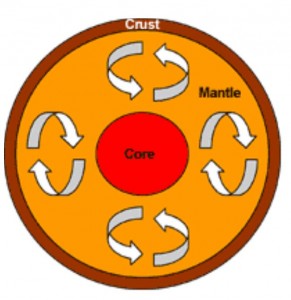PLATE TECTONICS AND PLATE BOUNDARIES
Excellent Video Summary for Chapter Exam
ASSIGNMENT:
Look at this video for a Quick Summary
- Click HERE for the Worksheet with the Lyrics
- Watch the Video and Complete the Lyrics
“Pangaea’s Moving Farther Apart Again”
(Credit to Mr. Parr – creator of many YouTube Videos for students)
Convection Currents in the Earth
As we were studying Continental Drift, we learned that although Alfred Wegener had a great theory, he was not able to explain HOW the continents moved. About 60 years later geologists started to look at the ocean floor, and they discovered that the ocean had a very long range of mountains which they called the Mid-Ocean Ridge. Scientists also learned more about what was happening in the mantle, and found that the heat of the core was creating Convection Currents n the mantle.
The tectonic plates rest on the asthenosphere, a layer of soft rock. Rock in the asthenosphere and in the rest of the mantle moves from convection.
Convection is energy transfer by movement of a material. Heat causes material to become less dense – it then rises, cools, becomes denser and then sinks, only to repeat again. In a pot of boiling water, the water gets heated at the bottom, rises to the top, cools when it hits the air, and then sinks again, forming a looped current.
Click on the picture to see the animation.
The core of the earth makes the heat. It causes the molten material in the mantle to rise, cool and then sink back to the center, where it gets heated again. Notice how the convection currents in the earth are all around the mantle, heated by the core.
The lithosphere is broken into tectonic plates, and these float on the asthenosphere. As the convection currents flow, the floating plates also move, very slowly, about an inch a year. This is what caused the continents to move! Look closely at the diagram, and then clink on the link below to see the movement.
As you can see by the animation, the convection currents in the mantle make the plates in the lithosphere move. Some of them move together to collide at a CONVERGENT BOUNDARY to form mountains, and some of them move apart at a DIVERGENT BOUNDARY to form cracks in the crust. Magma comes up through these cracks, creating a Mid-Ocean Ridge on the sea floor.
Click on the link below to see how new ocean crust is being made at the Mid-ocean Ridge, and that the new crust is pushing the older crust away. The farther you go from the ridge, the older the crust is. This is one way that scientists can prove that the plates are actually moving!
Click on the picture above to see the animation.
In class we then took notes on the Smartboard to review the convection currents in the mantle, their effect on the plates of the lithosphere, and we had an introduction to DIVERGENT and CONVERGENT boundaries. The plates move because of the convection currents in the asthenosphere (mantle) forcing the plates to flow with the current.
Khan Academy Video on Divergent Boundaries
Khan Academy Video on Convergent Boundaries
As a result, the Earth is broken into many
TECTONIC PLATES.
Look at the types of convergent boundaries above….what happens at each of these collisions?
Can you name the features that are formed with the types of collision
ISLAND ARCS
COASTAL MOUNTAINS
DEEP-OCEAN TRENCHES
FOLDED MOUNTAINS
Click on the picture below to see the animation we used in class.









this is a really helpful but i would of liked to see transformboundary drawing
I can send you the diagrams we use for transform boundary…just did not use them ion the site. Is this your correct email?